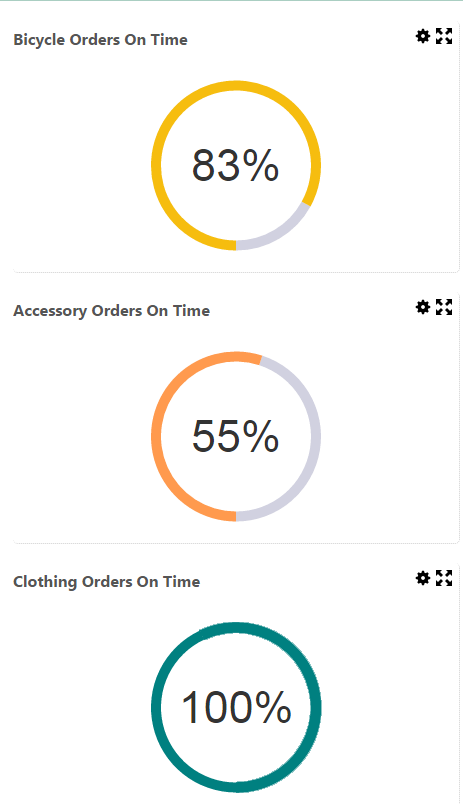 The modern business has access to more data than ever before. The problem is, this data often hurts decision making.
The modern business has access to more data than ever before. The problem is, this data often hurts decision making.
 The modern business has access to more data than ever before. The problem is, this data often hurts decision making.
The modern business has access to more data than ever before. The problem is, this data often hurts decision making.
As mentioned in Reuters, “Dying for Business” report, “One-third of managers are victims of ‘Information Fatigue Syndrome.’ 49% said they are unable to handle the vast amounts of information received. 43% think that important decisions are delayed and their abilities to make decisions are affected as a result of having too much information.”
What’s happening? Why are so many struggling with data?
For some, they haven’t set up standard reporting processes. Others have standard reporting processes, but their reports are ineffective. Still others use executive dashboards that are little more than charts and data on a page.
Today, let’s focus on that last point: Executive dashboards. When used correctly, executive dashboards cut through the clutter and give business leaders a clear view of the business. They drive action.
The problem is, many executive dashboards fail at this primary objective. They are overwhelming. They’re full of data, but don’t really provide clear insights. They don’t ultimately provide much value to your executives.
So, how can you create effective dashboards that your executives will love? Today, let’s answer that question. Here are a few tips:
Understand your audience

The first step in creating a dashboard that your executives will love: Understand your audience.
The fact is, not all executives care about the same data. For instance, the CEO will need different something different than the senior management team. The CMO will want far different data than the CIO.
Talk to those who will use the dashboard (or dashboards). Answer a few important questions:
What are their goals for the dashboard? If it is successful, how will you know?
What metrics do they care about?
Which metrics do they truly need? Now, this might sound like the last question, but it’s much different. You’ll find that some executives care about metrics that don’t drive action. They’ll want many different metrics on their dashboard–when they only really need a handful of them.
The question is, how do you know which metrics to keep and which to leave out? How do you know which metrics your executives truly need? Ask yourself, “What happens if this changes?” about every metric. If the answer is ambiguous or if you don’t know, it’s probably not a metric that they need. It’s not a metric that drives action.
“Make sure the information being presented is actionable,” says Alison Trapp, Principal, Lyon Consulting, LLC. “If your CEO isn’t going to do anything about a falling number of “likes” on the company’s Facebook page, don’t include it in the dashboard. Set triggers in advance. If you follow a six sigma methodology and have normal data, you’ll likely set these 1 or 2 standard deviations from the average. Otherwise, they are set at the point where you need to take action.”
Keep it to a single page
One way to ensure that you’re only including the most important data: Keep it to a single page. This forces the user to only keep those metrics that matter the most. It focuses the dashboard on only a few metrics.
Avinash Kaushik summed it up nicely in his article, Five Rules of High Impact Web Analytics Dashboards: “If your dashboard does not fit on one page, you have a report, not a dashboard. This rule is important because it encourages rigorous thought to be applied in selecting the golden dashboard metric. It acts as a natural barrier to cramming in too much information, makes data presentation easier, makes the dashboard more understandable.”
It’s a great rule to follow, but one that is commonly ignored. In general, ineffective dashboards are usually the result of trying to do too much. They try to include too many features or too much data. They try to fit as much information as possible on the screen. This negates the power of dashboards: Simplicity.
“You want to have a few options that executives can toggle without giving them an overload of options or they can get bogged down in trying to slice the data,” says Dustin Bolander, CIO of Technology Pointe. “For example on our client utilization reports you can select by team or industry vertical. If you need more flexibility you have to look at a different report. Simple is better!”
Give them insights (not just data)

The problem with most dashboards comes from a lack of insight, not a lack of data. They contain data, but rely on the executive to find insights. The problem is, the executive doesn’t always understand the data in the way that a data analyst might. So, while the dashboard might do a great job at summarizing data, its meaning might not be clear to the end user.
This article sums up the issue perfectly:
“People who are closest to the data, the complexity, who’ve actually done lots of great analysis, are only providing data. They don’t provide insights and recommendations.
People who are receiving the summarized snapshot top-lined have zero capacity to understand the complexity, will never actually do analysis and hence are in no position to know what to do with the summarized snapshot they see.
The end result? Nothing.
Standstill. Gut based decision making. No real appreciation of the delicious opportunity in front of every single company on the planet right now to have a huger impact with data.”
So, what’s the answer? How can you provide insights that ensure your executives can take action on the data? As explained below, it helps to give them a “plain English” description of the data. This might include insights into what the data means, or recommendations based on the data.
“Documentation and/or brief descriptions of the metrics reported are necessary,” says Dr. Jim Sullivan, Sr. Director, IT for Pharmaca Integrative Pharmacy. “These should include a “plain english” description as well as a simple calculation, and explanation of the time frame for the data. This prevents debate about what a number actually means, and also provides insight into what steps the business may need to take to improve the metric performance.”
Add context
 Suppose you’re the CEO of a manufacturing company. Your dashboard shows that you’ve shipped 75 widgets today, and that you’ve had 5 damaged products returned. Are those numbers good? How do they compare with industry averages? Can they be improved? Is that better or worse than the previous day?
Suppose you’re the CEO of a manufacturing company. Your dashboard shows that you’ve shipped 75 widgets today, and that you’ve had 5 damaged products returned. Are those numbers good? How do they compare with industry averages? Can they be improved? Is that better or worse than the previous day?
I share this example to highlight one incredibly important dashboard aspect: Context. Sure, your dashboard might display data, but without context…it means very little. Without goals, historical data, or industry benchmarks, your data doesn’t mean much.
What’s the best way to include context? With images and color. For instance, take a look at the image on the right. Not only do the gauges list the percentages, they’re color coded to add context. The orange color on the middle gauge illustrates that 55% is not an acceptable level, and should be investigated.
This is just one example, but you get the idea. Effective dashboards use colors and images to tell a story.
“A picture can tell a thousand words,” says Kenneth Ashe, Project Manager at Prudential Financial. “This is especially true for dashboards. Utilizing visuals in dashboards are a great way to convey a message. In project dashboards, by reporting a project as green, yellow or red, an executive can quickly see how a project is trending. Visuals become even more important in financial dashboards. Instead of communicating with data tables, graphs and charts should be used to tell the story. Not only are they more visually appealing, they are often easy to audiences to understand.”
Lets users dig into the data if necessary

A good dashboard will provide a high level view of your data and minimize noise. After all, executives want to look at their dashboard and get a big-picture view of the company.
But, what if your executives need more information on a certain metric? That’s where drill-downs come into play. For instance, if your dashboard displays product returns, it should also let the user drill down and see where products are being returned, reasons for the return, and any other pertinent information. An effective dashboard starts with a high-level view, and provides drill-down capabilities.
“Dashboards that can be drilled down into to answer questions with either filters or click-through reports are essential,” says Michael Shearer, Director, Marketing Operations, SelectHub. “These drill-downs and filters can answer more detailed questions that always arise during dashboard reviews/executive meetings.”
Provide customization options
With dashboards, one size doesn’t fit all. Different users want to see different data. Or, they may want to see the same data, but organized differently.
Yet, I still see many dashboards that display a pre-determined set of metrics in a pre-set layout. While each department might get their own dashboard, users within that department are stuck with a static layout.
For instance, a sales dashboard might display metrics like daily/monthly product sales, geographical sales numbers, top customers, and salesperson performance, to name a few. If one sales manager needed additional metrics or metrics that differ from the other sales manager’s dashboards, they run into problems. They must either create a brand new dashboard themselves or request a new dashboard from the IT department.
If you really want to get the most out of your dashboards, deliver customizable dashboards. Give each executive the ability to adapt their dashboard to meet their own specific needs.
Automate the data feeds
It’s a mistake I see all too often. Businesses create dashboards that rely on manual data updates. While it may seem feasible at the time, this mistake can cripple your dashboard.
Why is this bad? Besides the obvious time drain, it leads to out-of-date, inaccurate dashboards. While it may work for a little while, the employee in charge of updating the dashboard will eventually forget to make an update. Or, maybe they’ll make a mistake as they’re updating the dashboard.
The results can be disastrous. Executives go on using the dashboard, without knowing the data is out of date or inaccurate–resulting in misinformed decisions.
If you plan on using your dashboard as a decision-making tool, you must automate your data feeds. Don’t make your dashboard’s accuracy rely on manual processes.
Summary
These are just 7 tips for building dashboards that your executives will love, but the list could certainly be longer. If you would like to add anything to this list, I’d love to hear it. Feel free to share in the comments.





